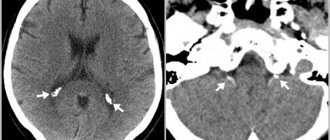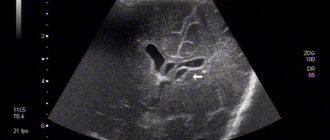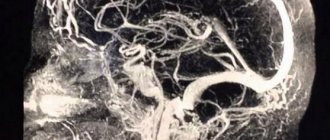Hypoxia, along with other pathologies of intrauterine development, poses a real danger to the health and life of an unborn child. In this article we will talk about different types of hypoxia, its causes, consequences, as well as the prevention and treatment of this pathology.
This pathology is a multi-organ syndrome that occurs due to the fact that oxygen does not reach the organs and tissues of the fetus in the required volume. The consequences are quite serious - from dysfunction of the central nervous system to the most dismal outcome. If acute fetal hypoxia is detected, immediate medical attention is required - the sooner it is provided, the lower the risk of complications.
Degrees of hypoxia: acute and chronic
Our body cannot live without oxygen, so even a short oxygen deprivation leads to serious consequences. There are two types of hypoxia – acute and chronic.
What is the difference between them? A simple example: if a piece of food is blocked in the respiratory tract, this causes acute hypoxia. And if you live for months in a stuffy, poorly ventilated room, this causes chronic oxygen starvation.
Chronic hypoxia as a result of constant stuffiness is often the cause of malaise in adults - it leads to decreased immunity, deterioration in the quality of sleep, frequent headaches, constant fatigue and weakness.
Important! During pregnancy, prolonged stay in a stuffy room is dangerous precisely because of the risk of developing intrauterine fetal hypoxia. Therefore, doctors recommend being in the fresh air as often as possible, since they assume that all the windows in the apartment are closed and there is not enough fresh air.
The fruit is 100% dependent on the environment in which it is located. Therefore, expectant mothers need to avoid stuffiness, large crowds of people and regularly ventilate the apartment where they spend a lot of time. There is a myth that the room only needs to be ventilated for 15 minutes in the morning and evening. Ventilation should be constant, but this is not always possible due to the environment - dirt, noise, drafts, allergies.
Acute fetal hypoxia during pregnancy is the nightmare of any obstetrician. It can develop due to pathologies of intrauterine development (for example, placental abruption), or during childbirth - due to abnormalities in the birth act.
Types of newborn asphyxia
Classification is carried out according to several criteria. First of all, depending on the time of development of the pathological condition, the following are distinguished:
- primary, or intrauterine asphyxia - develops directly in the womb;
- secondary, or extrauterine asphyxia – occurs in the first hours of the baby’s life.
In turn, primary asphyxia is also divided into two subtypes:
- antenatal, or chronic - develops even before the onset of labor;
- intrapartum, or acute - occurs during the period of uterine dilation and fetal birth.
Consequences: why is this intrauterine syndrome dangerous?
Until the moment the child is born, he does not have independent breathing. He breathes liquid with oxygen dissolved in it, which entered it through the placenta from the mother’s blood. Simply put, the child breathes the air that his mother breathes, and if there are problems with O2 delivery at any stage, a threat of fetal hypoxia is created.
When oxygen deficiency occurs, the child’s body begins to redistribute it so that first O2 enters vital organs (brain, heart and adrenal glands), and only then goes to the skin, kidneys, gastrointestinal tract and lungs. Because of this, the first violations affect the development of those organs and systems that, during hypoxia, received oxygen according to the “residual principle.”
Problems with chronic hypoxia:
- difficulty in adapting to stimuli in a newborn (convulsions, problems with appetite and breathing);
- risk of developing epilepsy;
- cardiovascular disorders;
- risk of kidney failure;
- enterocolitis, frequent regurgitation;
- secondary immunodeficiency;
What could be the consequences for a child in the future due to acute hypoxia? In this case, the central nervous system is primarily affected. Acute oxygen deficiency in the fetus can cause the following disorders:
- mental retardation;
- DIC syndrome;
- neurological disorders;
- cerebral edema;
- pulmonary hypertension;
- necrosis and ischemia of various organs.
Pathogenesis (essence of pathology)
For the health and life of a child, oxygen is needed, which is carried through the blood to all organs and tissues of the body. If there is not enough of it, then the blood in the organs is redistributed; this is a natural regulation of the body. Blood with important oxygen begins to flow mainly to the heart and brain. At the same time, other organs experience a lack of both. If the cause of oxygen starvation is not eliminated, then asphyxia gradually develops, and the nerve cells will not be able to exist for so long. They die off. This is the essence of the process of cerebral ischemia in newborns.
It is logical that the greater the risk for a child, the larger areas of the brain that are damaged. In some children with such problems, blood spills into the brain, which can have very sad consequences.
Main causes of hypoxia
There are four main causes of oxygen deficiency in the fetus: pathologies during pregnancy (for example, a conflict of Rh factors), illnesses of the mother, her bad habits and harmful environmental influences.
Pathologies during pregnancy . Hypoxia can be caused by postmaturity, entanglement with the umbilical cord, Rh conflict between the blood of mother and child, disturbances in the development of the umbilical cord and placenta, as well as pathologies of the fetus itself:
- intrauterine trauma;
- genetic abnormalities;
- developmental defects;
- hemolytic disease.
Mom's illnesses. The range of pathologies is very wide. One of the most common causes of hypoxia in this case is iron deficiency anemia.
Oxygen deficiency in the fetus can also result from:
- pyelonephritis;
- diabetes;
- diseases of the urinary and respiratory system;
- arterial hypertension;
- endocrine diseases;
- kidney diseases;
- diseases of the immune system.
Separately, it is worth mentioning the consequences of STIs (herpes, chlamydia, gonorrhea, mycoplasmosis, bacterial vaginosis, candidiasis and trichomoniasis), malnutrition, exhaustion and severe toxicosis in the mother.
Drinking alcohol and smoking. Why does the mother’s bad habits often result in fetal hypoxia? It’s all about the effect that the listed substances have on the inner surface of the alveoli of the lungs.
The alveoli have a special lubricant that ensures rapid delivery of oxygen to the blood. Alcohol vapor dilutes this lubricant, causing it to perform its function worse. This is just one of many other harmful effects of drinking alcohol during pregnancy.
Smoking also provokes the development of fetal hypoxia: the tars in tobacco smoke “clog” the alveoli, due to which lubrication is not produced in the required quantity. Smoking contributes to chronic hypoxia - both for the mother and the unborn child.
Environmental factors . Living in an ecologically unfavorable area, working in a hazardous industry, or in the presence of toxic substances in the air can also cause fetal hypoxia. A similar effect is caused by constant stay in rooms with poor ventilation, when the air contains too much carbon dioxide and too little oxygen.
Hypoxia in newborns and older children
Hypoxia (or oxygen starvation) is a fairly common pathology that occurs in children of all ages and especially in newborns.
In newborns, hypoxia is often provoked by diseases of the mother, which affect the intrauterine development of the child and complicate the birth process. These include problems with the circulatory system, heart failure, unhealthy lifestyle - smoking, alcohol, taking drugs prohibited during pregnancy - and much more. If a pathological birth is added to the child’s hypoxia, which arises from the mother’s illnesses, then the degree of hypoxia can increase many times.
In this article we will consider the initial manifestations of insufficient blood supply to the brain.
Damage to the cervical spine, perinatal encephalopathy, asphyxia and other diagnoses can be given to the child immediately after birth, which will be common causes of the development of cerebral hypoxia. Parents most often come to a pediatric neurologist or other specialized specialist when the child’s nervous system receives increased stress - the diagnosis is made immediately before school or in first grade. Moreover, according to experts, the number of such children today is 70-80%. The most common complaints from parents are:
- emotional lability of your child and weather dependence;
- high nervous excitability;
- speech dysfunction of varying degrees;
- difficulties with learning and concentrating;
- bad behavior;
- headaches and dizziness;
- visual impairment, etc.
Despite the fact that cerebral hypoxia as a result of vascular disorders is very often diagnosed in schoolchildren, its first symptoms can be noticed in the first year of a child’s life. Such children, literally from the first days, are characterized by increased excitability, they have sleep and appetite disturbances, increased muscle tone, and suppression of unconditioned reflexes.
The main and most common cause of hypoxia in children is birth trauma. Rapid labor, stimulation of labor, and cesarean section are a trigger for weakening one or another function of the child’s body, resulting in symptoms characteristic of vascular disorders. While moving through the birth canal, the baby's cervical region experiences enormous stress, which can cause displacement of the cervical vertebrae and lead to disruption of the blood supply to the brain.
No less common and dangerous is compression, deformation and damage to the bones of the skull. All this directly affects the membranes of the brain and the blood circulation and oxygen supply.
The nervous system, together with the muscular, skeletal, circulatory and other systems, is part of a single whole organism, and disruptions or changes in function and structure in one of them always cause failure in the others. Therefore, vascular disorders of the brain are always a complex of disorders and symptoms, characterized by individuality for each child. And if your child has some of these manifestations, it is advisable not to delay a visit to specialists.
Treatment of a child with hypoxia should always be comprehensive: the main thing in the process of treating vascular disorders is a favorable atmosphere in the family, a regime and corrective measures that contribute to the child’s recovery, observation by a neurologist, speech therapist, orthopedist and other specialists. Osteopathy has proven itself well in the treatment of hypoxia, since the osteopath, during correction, considers the child’s body as an integral system.
It is a mistake to believe that an osteopath will cure all diseases and forever relieve your child of all adaptive symptoms of vascular disorders of the brain, make him a good student and a successful person in life. Osteopathy only makes some changes, affecting the vascular and nervous systems, the child’s circulatory system and other systems. Since the most common cause of hypoxia is a traumatic injury that provokes impaired blood circulation in the brain, an osteopath must find the main source of the problem and restore these processes using gentle techniques. Osteopathic correction is especially effective in cases where the cause of the disorder lies in the displacement of the vertebrae, block of the sutures of the vault and base of the skull, or injuries of the cervical spinal column. After all, the blood supply to the brain depends on the correct location of the meninges, skull bones and vertebrae and the possibility of free micromovements. During treatment, positive dynamics are not immediately observed. An osteopath can work with both large organs, bones and muscles, and very subtle matters and not only heals them, but directs the child’s body to independent adaptation and correction of congenital and acquired disorders.
It is desirable that osteopathic treatment be combined with a complex of other therapeutic and preventive measures, including physical therapy, constant classes and exercises with the child, work on his upbringing, etc. For example, if the blood circulation in the speech areas of the brain is impaired, the child may pronounce words or letters incorrectly. With osteopathic treatment, restoration of blood supply to these areas will improve the condition of damaged neural connections, and the child’s speech apparatus will have more opportunities to adapt to the new conditions of the body. This moment will be the most fruitful if you work with the child, instilling in him the correct pronunciation. As a result of regular classes, he will learn to speak and think correctly without outside help. We can observe the same processes with disorders in physical development, psychological state, etc.
It is obvious that the mechanical consequences of injury cannot be eliminated with any medications. An osteopath has a large variety of soft manual techniques in his arsenal, which can be used to eliminate the root cause and thereby remove obstacles to good blood circulation and cerebrospinal fluid flow. And the body will then begin to work on its own, because... The self-healing process will begin.
Osteopathic sessions for children with vascular disorders of the brain are usually prescribed once a week and last no more than 30-60 minutes. The duration of the therapeutic course is selected individually in each case. As a rule, after four to five sessions it is possible to normalize the patient’s condition and create the conditions necessary for the proper development of his body. Therefore, if it is important for parents not to let mild hypoxia of their child’s brain turn into more severe forms, it is advisable to see a specialist if there are any abnormalities.
GET A FREE CONSULTATION BY PHONE
+ 7 (495) 114-14-95
How to identify hypoxia: symptoms and diagnosis
The modern level of medicine makes it possible to detect the presence of hypoxia “without delay”, at its earliest stage. There are a number of diagnostic methods for this:
- analysis of the biochemical composition of blood and hormones;
- listening to heart sounds with a stethoscope (detection of bradycardia and tachycardia);
- amnioscopy - analysis of amniotic fluid (a sign of hypoxia - the presence of meconium in its composition);
- ultrasonography;
- cardiotocography;
- ECG;
- Dopplerometry (study of the circulatory system, analysis of blood circulation in all its areas).
What should you pay attention to? Very strong, sharp kicks of the child that cause pain in the mother are an alarming sign. They may be a consequence of the development of hypoxia: these are reflex movements when the child experiences a lack of oxygen and wants to increase the incoming blood flow. The next symptom is the weakening and complete disappearance of tremors.
Important! The child’s activity norm is at least ten movements in 12 hours.
At what point should fetal activity be monitored? Doctors recommend monitoring your sensations, frequency and strength of kicks, starting from the 28th week of pregnancy. However, the risk of developing hypoxia exists from the first weeks, when it is impossible to monitor fetal activity.
If there are risk factors, then obstetrician-gynecologists recommend a set of measures to prevent oxygen deficiency. In addition, the mother needs to eat in a timely and nutritious manner, avoid lack of sleep and overwork, spend more time outdoors, and ensure regular ventilation in the room.
Assessment of the baby's condition using the Apgar scale . At birth, obstetricians evaluate the baby's condition using Apgar scores (named after the author of this technique, Virginia Apgar). This method analyzes five criteria - breathing, skin color, muscle tone, and heart rate. The child's condition is assessed twice - immediately after passing through the birth canal, and five minutes after that.
- Norm (from 8 to 10 points);
- The condition requires control (from 4 to 7 points). Moderate hypoxia is possible, compensation may be required, prognosis is favorable;
- Asphyxia ( from 0 to 3 points). Severe hypoxia, in which the child requires immediate resuscitation measures.
Low scores on this scale are not always given due to hypoxia, but in most cases it is oxygen deficiency that causes the difficult condition of the newborn.
Degrees
- light
With mild ischemia, muscle tone increases, but not too much. Deep tendon reflexes in such children are enhanced. They suckle poorly, cry constantly, or, conversely, sleep constantly. During the first 3 days of life, manifestations of pathology are eliminated. Children who have not spent 9 months in their mother’s belly may have decreased rather than increased reflexes and muscle tone.
- average
- frequent apneas
- decreased grasping and sucking reflex
- sluggish Moro reflex
- decreased tendon reflexes
- weak muscle tone
Symptoms of moderate ischemia in newborns appear in the first 24 hours after birth. Doctors talk about a favorable prognosis if the symptoms of ischemia disappear within 14 days.
- heavy
- uncoordinated eye movements
- strabismus, nystagmus
- lack of reflexes that a newborn should normally have
- irregular breathing, such children have to be connected to a ventilator
- stupor or coma
- convulsions
- surges in blood pressure (BP)
- heart rhythm disturbances
Treatment and prevention
Treatment in this case involves normalizing blood flow and a stable supply of oxygen to the blood. Doctors draw up a treatment plan based on the results of the examination and studies performed. In some cases, due to a threat to the life of the fetus, labor is induced using medications.
Hypoxia is a serious pathology, therefore only a doctor has the right to prescribe treatment. There are no ready-made, universal treatment regimens. There are only general recommendations for pregnant women - rest, bed rest, sleeping on your side.
Prevention. A woman is required, first of all, to be responsible in preparing for pregnancy - preliminary treatment of the reproductive organs, adherence to the rules of a healthy diet, complete abandonment of bad habits, and physical activity.
Frequent walks in the fresh air are an important part of prevention. It is also necessary to ensure that the ventilation in the house works properly and that effective air exchange is ensured. A practical solution would be to install compact supply ventilation with a set of filters - this way you can be sure that there will always be fresh, clean air in the house.
Condition monitoring. After conception, regular medical monitoring of the fetus's condition is necessary. Special attention should be paid to the prevention of anemia, as it is one of the common causes of hypoxia. If hypoxia has been diagnosed, the correct choice of birth method is necessary, as well as measures to prevent birth injuries.
Cerebral ischemia in prematurity and in full-term infants
At term and at prematurity, the nature of brain damage is different. If a baby is not carried to term for 9 months, he or she is at risk of periventricular leukomalacia (PVL). This means that the white matter of the brain, located near the ventricles, dies and cysts form there.
PVL causes dementia and cerebral palsy in those born before the 31st week of gestation.
And for those who spent the entire period in the mother’s belly, damage mainly occurs to the cerebral cortex, that is, to the gray matter. The consequences for the child will depend on where the necrotic zone is located and how large it is. In acute and severe asphyxia (suffocation), damage to the brain stem is likely. Therefore, the child will have problems with heartbeat and breathing, which in some cases causes death, that is, death.
Ventilator OXY as a means of preventing fetal hypoxia
Constant stuffiness is one of the causes of chronic hypoxia. Ventilation problems usually occur due to poorly functioning hoods and the installation of plastic windows that “seal” the room. In this case, supply ventilation will help “start” normal air exchange.
An example of such ventilation is the OXY ventilator - a compact device equipped with a fan and a set of filters. To install it, a channel is drilled in the outer wall onto which the ventilator is mounted.
The OXY ventilator is an effective means of preventing fetal hypoxia. Immediately after installation, it provides a round-the-clock supply of fresh air with the windows closed. With it, the expectant mother will not be disturbed by street noise, dirt and drafts. Thanks to the optimal oxygen content in the atmosphere of the room, you will be provided with complete, healthy sleep and rest, good health and mood.










